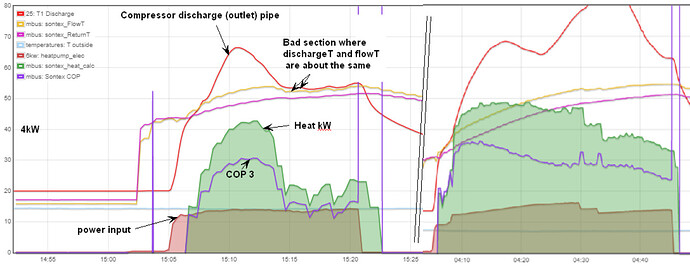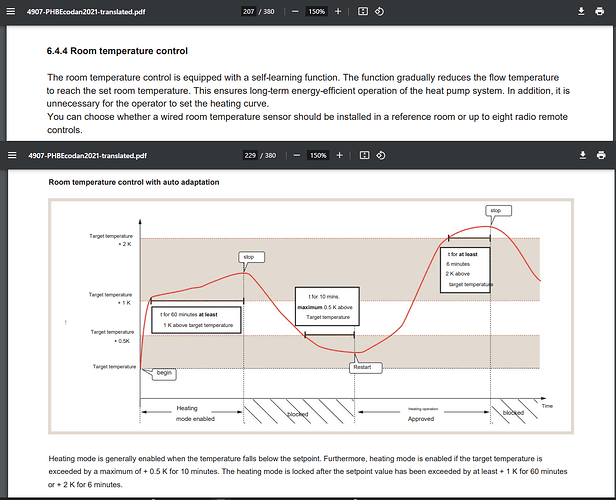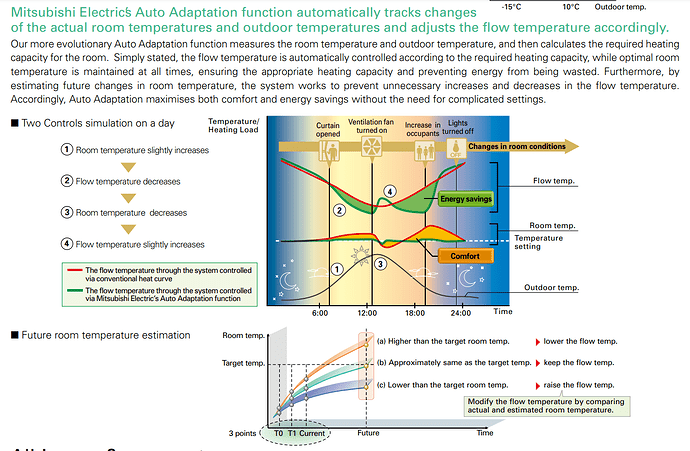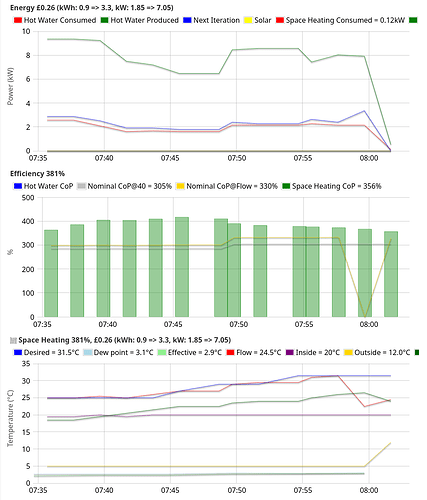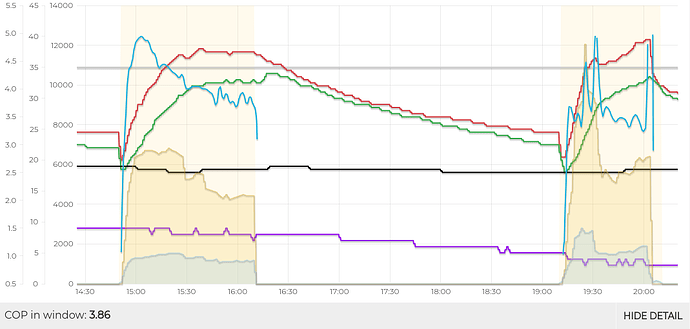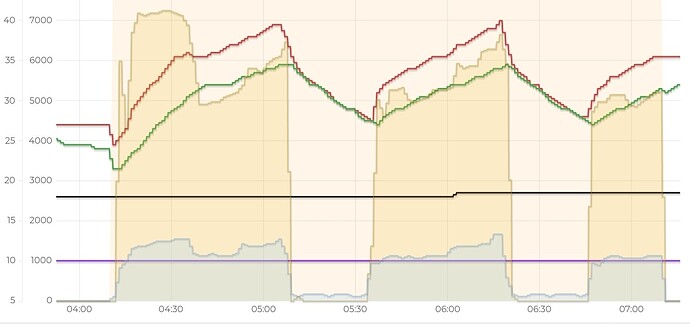Yes, this is exactly what my 6kW used to do (before I took it out!) Are you faliliar with ‘running information’ in the service menu? You would find that the compressor discharge superheat will be a healthy 20, 40 degrees etc, but at 01:00 it will have gone to zero. I thought this impossible, but modern compressors can cope with liquid entering the suction side https://www.youtube.com/watch?v=RXV-35gfQrk&t=22s
what is happening is evaporation is happening in the compressor instead of outside. Normally, your air-out from the unit might be 4 degrees colder than air-in, but at 01:15, I bet your air out of the unit will be less than 1 degree colder. I gave up trying to discuss with Mitsubishi since they never acknowledged it as a problem
I have been asked by a few people who want to know more about what goes on inside. maybe I should do a Youtube about it? I have a few 1/2 written blogs, one on how components and HPs have evolved over time… It might be of interest. i should finish it!
Andrew, your dt is a bit close. It might be worth slowing down the flow rate a notch…
Thanks John, Will have a look at the video later.
Do you know the running information code for compressor discharge? I’ll see if I can catch it when the output dips.
That would be great. There are lots of easy to access videos on the basics of a heat pump and best system configurations but it would be good to watch something that dives a bit deeper into what’s inside one.
Ok I’ll knock back the pump speed and see what happens. I think when I tried before the flow temp rose steeper so cycles got shorter but I might be misremembering and maybe I didn’t give AA long enough to adjust.
These are ‘running information’ codes (though can vary with different FTC versions)
I have in the past watched LEV valves 022 & 023. These will probably be moving a lot when its unhappy, but I dont know what to do with that information.
I think zero discharge superheat may happen occasionally when things look reasonably healthy, but I bet it was zero for a long period when the output drops so dramatically, and input power stays level.

My Ecodan is the Weymouth 14kW unit languishing someway down the ‘league’ but is actually performing extremely well now.
Just going to take some time to make up for last Winter’s numbers.
For those of you easily offended, don’t read on …
The original install was weather compensation with a four-pipe buffer tank on a two zone exiting gas CH controlled by Nest thermostats. Almost all emitters were upgraded to K2 and larger area where possible/desirable.
It performed extremely badly.
I now run a three pipe buffer system (thanks to input from John Cantor of this parish), two remote Mitsubishi wireless controllers (one for each zone) with the system running two-zone auto-adaptation, active TRVs everywhere except on the emitters in the lounge and upstairs hallway (where the controllers are).
Upstairs is set to 20C 6AM to 10PM, setback to 18C overnight.
Downstairs 20C 6AM to 5PM, 21C 5PM to 11PM, setback to 19C overnight.
DHW reheat is on-demand to 55C with a low of 45C.
The numbers from last Winter were an SCOP of high 2.6.
I’ve had an SCOP 4.4 over the last month, running COP is high 4 point something.
Any control system which ignores indoor temperature and requires manual intervention / tweaking of various parameters isn’t a control system for anyone other than some people on forums such as this.
The question I always ask myself is how would my 83 year old parents handle a new heat pump install if they had to do that? The answer of course is that they couldn’t.
Hi John,
I’m pulling data from melcloud but some of such parameters cannot be pulled via the melcloud API interface.
Do you have any other way apart the manual pulling via the FTC UI interface ?
Cheers,
Ale
I am not the person to ask about getting that data out. Others might know. I fitted an ds18b20 sesnor to the compressor discharge pipe (red line). It’s tricky to fit well onto such a small pipe. This was very useful for seeing what was happening. As this shows, the discharge should be superheated (as times when COP is good). Where the discharge temperature drops to a similar value as the flow temperature, the COP is very poor
Well done for the improvements that you have made. its great to share your experience, and we hope that others can do the same sort of thing so more and more people can gain experience from others. Its interesting how quite a few of us dont use weather comp, but it can be used very sucessfully. I have always liked the ‘auto adapt’ type control. The outside air is not necessarily the ideal basis for radiator temperatures.
You’re clearly doing something very right @greentangerine
You got your 14kW Ecodan down to drawing just 1kW this evening:
I’ve only ever seen mine go down to 1.6kW and that’s very rare.
Do you attribute your low draw to switching to the auto-adapt Mitsubishi controllers?
I’ve absolutely no idea tbh.
I went to auto adaptation because the Nest thermostats controlling the WC curve setting (I e. on or off) wasn’t working well at all and with a lot of solar gain, I couldn’t persuade myself then (and still can’t) that the system not knowing the internal temperature and relying on the temperature outside was in any way a sensible control method that can run without inveterate frobnication.
Unfortunately Mitsubishi don’t publish much at all about auto adaptation but for me it’s working fine, TRVs and all.
The three pipe buffer tank probably helps greatly as well by adding some volume.
I found the trouble with both fixed flow and weather compensation modes is a) FTC tries to get up to target temperature as fast as possible, and b) doesn’t wait long enough between cycles to let the system cool down again. I personally prefer auto adapt because it’s in less of a hurry to get hot, and it pauses between cycles for the flow to drop by 10 C.
There are settings on the FTC that affect room mode but not the other modes.:
Yes I find it strange that can set the lower and upper limits for AA but with WC there is no way to set the hysteresis.
I suppose if I had a perfectly designed system that wouldn’t be an issue as the emitters would be correctly sized to get rid of the heat and the heat pump able to modulate down its output to give nice long runs.
I’ve only just now figured out that the minimum flow temp for my system is 35 C if I want nice long runs, as that’s how hot my radiators need to be in order to emit 4 kW from the heat pump on it’s lowest power. Unfortunately, the house only needs that amount of heat at 0C or below…
[see this post in another topic for numbers]
I thought your occupants were helping by leaving the windows open ![]()
Can any of you just confirm my interpretation of what the auto-adapt is doing? I believe it’s doing something like this where I gently walk the desired flow temperature (blue line in space heating) up to stop it racing up to the number you would have for weather compensation.
For example here the weather comp flow temp is about 32 but I hold the desired flow temp down and gently walk it up from 25 to 32 so my oversized Ecodan doesn’t get carried away.
Given the outdoor temp of about 5 °C the CoP Mitsubishi predict is about 3 so you can see it helps in my case bring it up to about 3.8.
Yes, that’s a defrost at 08:00 which sadly seems to have heated the outside up to a balmy 12 °C.
Edit:
Yep, it’s doing the flow temp stuff and a bunch of other things.
It’s similar to what I have to manage the flow temp and to decide if things should be on using hysteresis. As @Timbones has said a number of times, it’s better for the family if it’s based on a vendor-supplied and supported bit of tech than hand-rolled sketchy scripts.
The next trick is to get auto-adapt to use the effective outdoor temp by taking account of the humidity and wind-speed which I’ve been using to nudge up the weather comp curve when it’s stormy because our 200 year old house gets more of a chill with the wind and rain lashing against it ![]()
Sometimes it eases up slowly (first cycle below, COP 4.2) but othertimes it will still up race up to WC temp quickly (2nd cycle, 3.7), perhaps because it was colder out?
The only nudging I do is to periodically check the room temperature, and if it’s 0.5 C above the set point I’ll knock the thermostat down by 0.5 C - i.e. “the house is warm enough now, thanks”. Otherwise auto-adapt will keep warming the house up to +1 C. Though maybe I should leave it alone to do all the “intelligent learning” the marketing says it does…
Auto Adapt: I’ve noticed that the first cycle in a set (i.e. while thermostat calls for heat) ramps up quicker than subsequent cycles. See this period from this morning:
